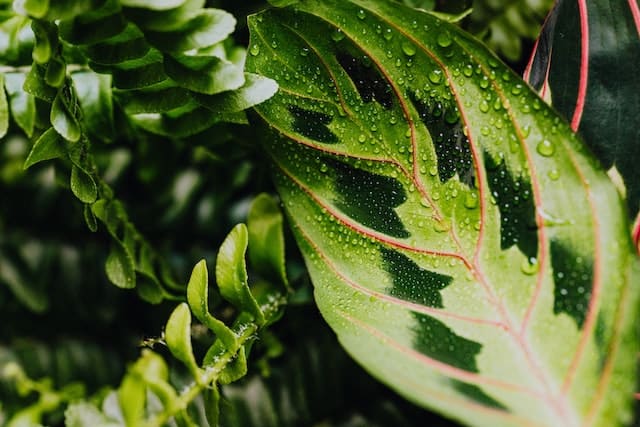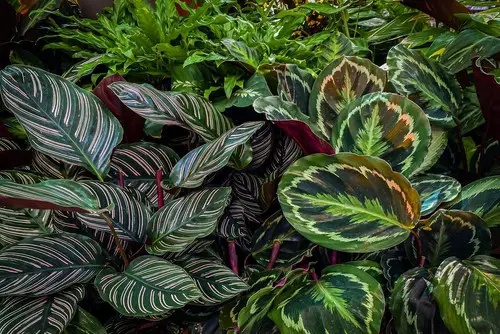For those who enjoy indoor plants, calathea is among the most popular houseplants. Calatheas are beautiful plants that make any indoor space more inviting. However, a Calathea not closing at night could indicate the plant is under high stress.
Calatheas close their leaves at night and open them in the morning by the sun’s rising and setting. Too much artificial light, irregular lighting schedules, underwater and overwatering, and pests can prevent the plant from closing each night.
It looks like there are a few reasons why a Calathea wouldn’t close at night. In this article, we’ll explore why your plant won’t close and what you can do to help your plant.
But come to think of it, do all Calathea plants close at night? If yes, why do they fold up their leaves? Let’s answer these questions before we proceed!
Do All Calathea Close At Night?
Surprisingly, the answer is yes! All common species of Calathea close at night. In fact, all the plants belonging to the Marantaceae family exhibit the same behavior. This allows the plants to conserve energy when they don’t get enough light or aren’t fully active.
It’s no wonder why they’re known by the name “the prayer plant family.” During the day, the Calathea plant opens its leaves to get enough light, and it folds them up by night.
Why Do Calathea Leaves Close At Night?
As of now, there’s no specific answer as to why the plants fold up their leaves. But this behavior is assumed to be a result of the plant’s circadian rhythm or hormonal changes.
According to popular belief, these plants close up their leaves to protect themselves against fungal infections. When the leaves close, water will not be able to gather on their surfaces but will instead drip down. These plants are also believed to regulate water loss and temperature by folding their leaves.
Another assumption is that the Calathea plant closes its leaves as a form of defense against pests.
Calathea Not Closing at Night

Not all Calathea plants are dramatic when their leaves fold. Some of the plants only slightly shift while others fold up completely. It’s important to know which type of plant you have to be able to diagnose a possible issue properly.
There are a few instances where the leaves stop closing. For example, older leaves at the bottom may slowly die off and no longer close at night. If the joint connecting the leaf to the stem is damaged, the leaves can no longer close. You can identify these problems on a leaf-by-leaf basis.
1. Too Much Light
Calathea plants rely on an internal rhythm to know when they close their leaves at night. This rhythm, also known as circadian or diurnal, can be affected by too much light exposure at odd hours.
Artificial light will also affect the plant’s rhythm, meaning keeping the plant in a room where the lights are off at night is important.
Sporadic light changes can also cause the plant to open and close incorrectly. If your household has lights on and then off every few hours, the plant can become confused and unable to tell time. Don’t worry – this is an easy fix if you have any windows in your home.
The plant will return to its natural rhythm within a few days of a steady light source. I recommend placing your Calathea near a large, unblocked window in a room where artificial light isn’t often used at night. this will help the plant close its leaves at night.
2. Overwatering

Calatheas require frequent watering but require soil that drains well. The roots don’t like to sit in damp soil and can develop root rot if not taken care of.
This can stunt the plant’s growth and make it more difficult to absorb nutrients. If the plant can’t absorb nutrients, it will stop “unessential” movements like closing the leaves.
You can tell if the plant is being overwatered by feeling the soil a few hours after you water it. If the top layer of the soil feels soggy (more than damp), the plant isn’t drinking all the water you’re putting in. The leaves and stems may also begin to droop, and mold may start to grow on the soil’s surface.
3. Underwatering
It’s easier to underwater a Calathea than overwater it due to its love of water. This is easier to tell because the soil will be consistently too dry to absorb water and may even float on top when water is introduced. The leaves may wilt, curl, and brown in an underwatered plant.
In comparison, underwatered Calathea plants may keep their leaves closed all day to preserve moisture loss. So, if you notice that your plant is only closed and won’t open during the day, give the soil a check to see if it needs to be watered.
4. Pests

Unwanted critters on your Calathea may be why the leaves won’t close. Spider mites are the most common pest for indoor Calatheas and eat the joint that moves the leaves. You’ll need to carefully inspect the plant to determine if you have any stowaways.
A magnifier with a red light will help you see the spider mites, which are tiny and difficult to spot. The mites can either be red, brown, or black. Their webs will be located where the stem meets the leaf. Depending on the size of the infestation, they can quickly kill your Calathea.
To eliminate the infestation, take a cotton ball soaked in rubbing alcohol and thoroughly wipe the stems and leaves. Then, mix dish soap and water and spray the plant. The soap bubbles help trap the mites and kill them. After a few hours, rinse the leaves off. Keep a close eye on the plant for the next few weeks.
5. Humidity and Temperature Fluctuations
Calathea plants like high humidity and warm temperatures. The leaf movement can slow down and minimize if the plant isn’t receiving a high enough humidity or is receiving too cool a temperature.
If this is the only thing wrong with the plant and you’ve checked the rest of the possibilities, your plant may need time to adjust to a new environment.
Humidity and temperature (unless below 55 F) will not kill your plant.
Also read: Calathea Drooping
Conclusion
A Calathea not closing at night could indicate several things wrong with the plant, such as overwatering and underwatering, too much light, pests, and humidity and temperature changes. Though they seem dramatic, Calathea plants are hardy and make an excellent addition to any indoor location.
Frequently Asked Questions
Why does my Calathea not close at night?
Calathea plants droop their leaves during the day and fold them closed at night. If you’re noticing your plant staying open and haven’t seen any other health concerns, the plant is most likely receiving too much light. Even artificial light can affect a plant’s circadian rhythm.
Why does my Calathea open at night?
You may be overwatering or underwatering your plant, resulting in a stressful environment. When stressed, plants can go dormant, and you won’t see their standard opening and closing. This can adversely affect the plant later on.
Does Calathea close its leaves at night?
Calathea plants close their leaves at night and open them again in the morning. This has given them the nickname the “living plant.” The leaves can do this thanks to a small joint-like spot between the leaf and the stem.

Hey, I’m Lisa and I’ve been an avid gardener for over 30 years. I love writing, talking and living in the garden! Feel free to connect with me on my socials below

